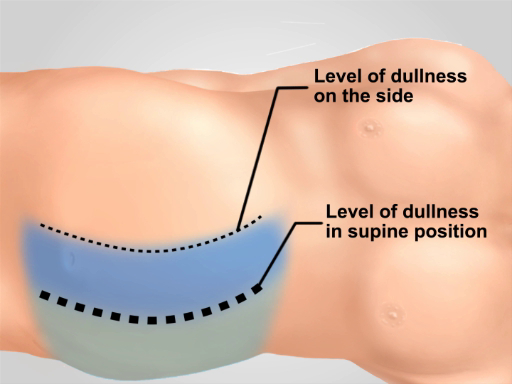Abdominal Exam II: Percussion
Overview
Source: Alexander Goldfarb, MD, Assistant Professor of Medicine, Beth Israel Deaconess Medical Center, MA
Medical percussion is based on the difference in pitch between the sounds elicited by tapping on the body wall. The auditory response to tapping depends on the ease with which the body wall vibrates, and is influenced by underlying organs, strength of the stroke, and the state of the body wall. There are three main medical percussion sounds: resonance (heard over lungs), tympany (heard over the air-filled bowel loops), and dullness (heard over fluid or solid organs). The contrast between dullness vs. tympany or resonance allows for determination of the size and margins of organs and masses, as well as identification of fluid accumulation and areas of consolidation. Percussion remains an intricate part of the physical diagnosis since it was first introduced more than 200 years ago, and is especially useful in examination of the lungs and abdomen.
As a part of an abdominal examination, percussion follows visual inspection and auscultation. The examiner should first percuss over each of the nine abdominal regions (epigastric region, right hypochondriac region, left hypochondriac region, umbilical region, right lumbar region, left lumbar region, hypogastric region, right inguinal region, and left inguinal region). Tenderness elicited by percussion is abnormal, and peritoneal inflammation should be suspected. As the air-filled bowel loops are positioned in the closest proximity to the abdominal wall, the percussion over most parts of the abdominal cavity elicits a predominantly tympanic sound. The presence of large areas of dullness should prompt evaluation for organomegaly, intra-abdominal masses, or fluid.
In addition to assessing the amount and distribution of abdominal gas, an abdominal exam should include an estimation of liver and spleen size by percussion. As the liver and spleen are covered by the rib cage, the examiner should percuss over the lower anterior chest as well. Normally, one expects to hear dull sound on percussion of the right anterior chest over the liver, and tympanic sound on percussion of left anterior chest over the gastric air bubble and the splenic flexure of the colon (Figure 1).

Figure 1. Normal percussion notes over abdominal region. With the exception of an area of dullness over the liver in the right lower anterior chest, tympany is the predominant sound heard over the region.
Procedure
1. General percussion of the abdomen
- Explain the procedure to the patient
- Perform light percussion over each of the nine abdominal regions.
- As you percuss, watch the patient's face for any signs of discomfort. Ask the patient if they are experiencing any tenderness. Tenderness on percussion is abnormal and can indicate peritoneal inflammation.
- Listen to the intensity, pitch, and duration of the percussion note. Normally, tympanic sound produced by air in the bowel loops will
Application and Summary
Despite rapid advances in imaging techniques, abdominal percussion remains an essential part of a physical examination. Correct percussion technique is critical for this method to be effective. The percussion strike should be kept the same over the entire abdomen. All the information obtained during the patient's interview and full physical examination, and a good knowledge of differential diagnoses of each pathological sign is essential for proper interpretation of any findings. For example, a false increase of liver
Tags
Skip to...
Videos from this collection:

Now Playing
Abdominal Exam II: Percussion
Physical Examinations II
248.3K Views

Eye Exam
Physical Examinations II
77.3K Views

Ophthalmoscopic Examination
Physical Examinations II
68.0K Views

Ear Exam
Physical Examinations II
55.2K Views

Nose, Sinuses, Oral Cavity and Pharynx Exam
Physical Examinations II
65.8K Views

Thyroid Exam
Physical Examinations II
105.1K Views

Lymph Node Exam
Physical Examinations II
387.8K Views

Abdominal Exam I: Inspection and Auscultation
Physical Examinations II
202.8K Views

Abdominal Exam III: Palpation
Physical Examinations II
138.6K Views

Abdominal Exam IV: Acute Abdominal Pain Assessment
Physical Examinations II
67.3K Views

Male Rectal Exam
Physical Examinations II
114.7K Views

Comprehensive Breast Exam
Physical Examinations II
87.7K Views

Pelvic Exam I: Assessment of the External Genitalia
Physical Examinations II
307.7K Views

Pelvic Exam II: Speculum Exam
Physical Examinations II
150.5K Views

Pelvic Exam III: Bimanual and Rectovaginal Exam
Physical Examinations II
147.9K Views
Copyright © 2025 MyJoVE Corporation. All rights reserved
